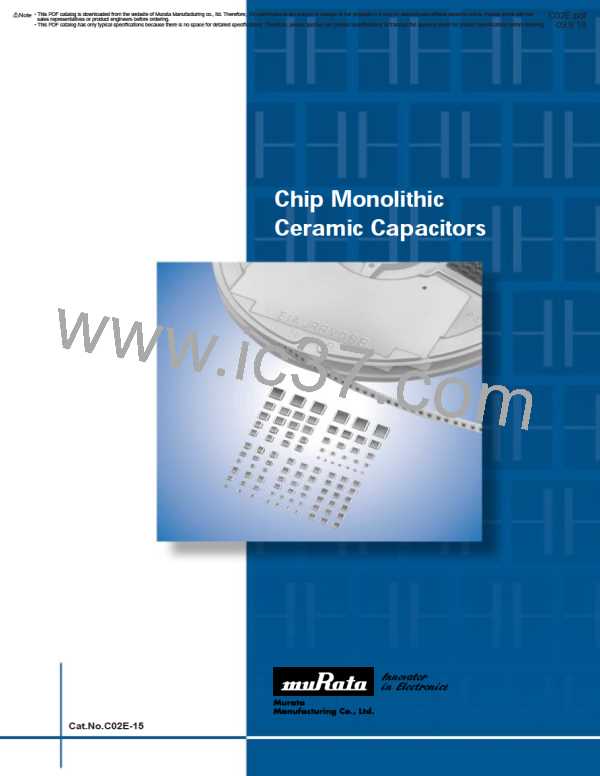• This PDF catalog is downloaded from the website of Murata Manufacturing co., ltd. Therefore, it’s specifications are subject to change or our products in it may be discontinued without advance notice. Please check with our
• Please read rating and !CAUTION (for storage, operating, rating, soldering, mounting and handling) in this catalog to prevent smoking and/or burning, etc.
!Note
!Note
C02E.pdf
sales representatives or product engineers before ordering.
• This catalog has only typical specifications because there is no space for detailed specifications. Therefore, please approve our product specifications or transact the approval sheet for product specifications before ordering0. 9.9.18
• This PDF catalog has only typical specifications because there is no space for detailed specifications. Therefore, please approve our product specifications or transact the approval sheet for product specifications before ordering.
ERB Series Specifications and Test Method (1)
ERB Series Specifications and Test Methods
Continued from the preceding page.
Specifications
No.
Item
Test Method
Appearance
Capacitance
No defects or abnormalities
Within the specified tolerance
Solder the capacitor to the test jig (glass epoxy board) in the
same manner and under the same conditions as (10).
The capacitor should be subjected to a simple harmonic motion
having a total amplitude of 1.5mm, the frequency being varied
uniformly between the approximate limits of 10 and 55Hz.
The frequency range, from 10 to 55Hz and return to 10Hz,
should be traversed in approximately 1 minute. This motion
should be applied for a period of 2 hours in each of 3 mutually
perpendicular directions (total of 6 hours).
Satisfies the initial value.
Vibration
Resistance
11
220pFFCV1,220pF : QU10,000
220pFFCV1,470pF : QU15,000
470pFFCV1,000pF : QU13,000
C: Nominal Capacitance (pF)
Q
Appearance
No marking defects
Capacitance
Change
Within T5% or T0.5pF
(Whichever is larger)
Solder the capacitor on the test jig (glass epoxy board) shown
in Fig. 2a using an eutectic solder. Then apply a force in the
direction shown in Fig. 3a. The soldering should be done by
the reflow method and should be conducted with care so that
the soldering is uniform and free of defects such as heat shock.
20
Pressurizing
50
speed : 1.0mm/sec.
Pressurize
b
c
6
ø4.5
R230
12 Deflection
Type
a
b
c
ERB18
ERB21
ERB32
1.0
1.2
2.2
3.0
4.0
5.0
1.2
1.65
2.9
Flexure : V1
a
Capacitance meter
(in mm)
100
45
45
t : 1.6mm
Fig.3a
Fig. 2a
Immerse the capacitor in a solution of isopropyl alcohol and
rosin (25% rosin in weight proportion).
Preheat at 80 to 120D for 10 to 30 seconds.
After preheating, immerse in an eutectic solder
or Sn-3.0Ag-0.5Cu solder solution for 5±0.5 seconds
at 245±5D.
Solderability of
Termination
95% of the terminations are to be soldered evenly and
continuously.
13
The measured and observed characteristics should satisfy the
specifications in the following table.
Preheat according to the conditions listed in the table below.
Immerse the capacitor in an eutectic solder or Sn-3.0Ag-0.5Cu
solder solution at 270±5D for 10±0.5 seconds. Let sit at room
temperature for 24±2 hours.
Item
Appearance
Capacitance
Change
Specifications
No marked defect
Within T2.5% or T0.25pF
(Whichever is larger)
Resistance
to Soldering Heat
14
Chip Size
2.0Z1.25mm max.
3.2Z2.5mm
Preheat Condition
1minute at 120 to 150D
220pFFCV1,220pF : QU10,000
220pFFCV1,470pF : QU15,000
470pFFCV1,000pF : QU13,000
No failure
Q
Each 1 minute at 100 to 120D and then 170 to 200D
Dielectric Strength
C: Nominal Capacitance (pF)
The measured and observed characteristics should satisfy the
specifications in the following table.
Fix the capacitor to the supporting jig in the same manner and
under the same conditions as (10). Perform the five cycles
according to the four heat treatments listed in the following table.
Let sit for 24T2 hours at room temperature, then measure.
Item
Appearance
Capacitance
Change
Specifications
No marked defect
Within T5% or T0.5pF
(Whichever is larger)
Step
1
2
3
4
Temperature
Cycle
15
10pFVCU30pF : QU350
10pFVCF30pF : QU275W
10pFVCF10pF : QU200W10C
1,000MΩ min.
Min.
Operating
Temp. W0/Y3
Max.
Operating
Temp. W3/Y0
5
2
Room
Temp.
Room
Temp.
C
Q
Temp. (D)
I.R.
30T3
30T3
Time (min.)
5 max.
5 max.
No failure
Dielectric Strength
C: Nominal Capacitance (pF)
Continued on the following page.
117

 MURATA [ muRata ]
MURATA [ muRata ]